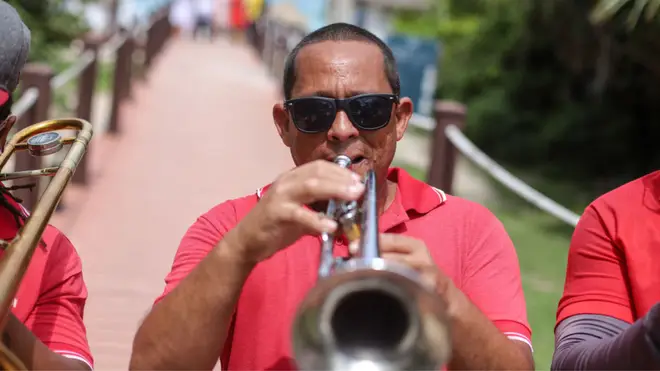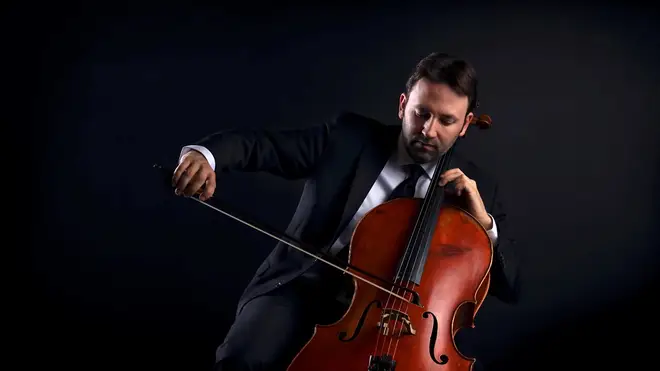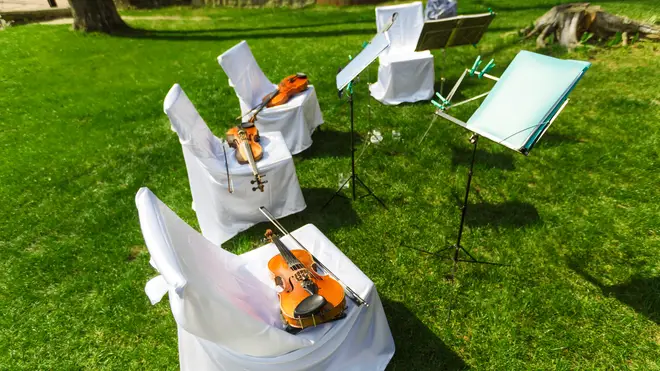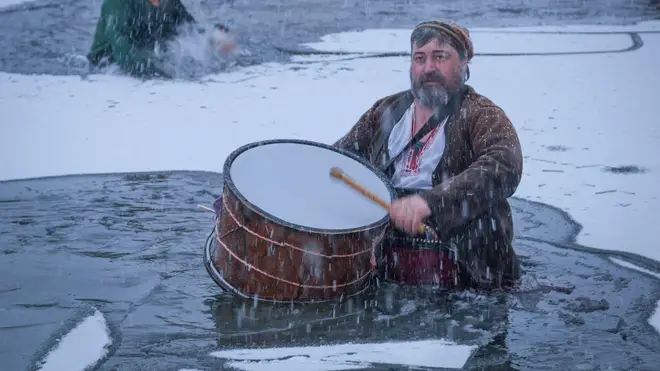On Air Now
Calm Classics with Myleene Klass 10pm - 1am
19 July 2022, 18:28 | Updated: 18 September 2023, 10:14

Why do our musical instruments morph in extreme temperatures? We speak to musicians and musical instrument makers on how best to practise and perform in both high heat and cold weather.
Musical instruments can be greatly affected by the climate, from minor tuning issues to potential long-term damage – and every instrument responds in its own way. While wind instruments often go flat in the cold, string instruments become sharp in the same climate.
As many countries across the world experience a heatwave, and with the UK recording its hottest day on record at 40 degrees Celsius, we find out how to keep your instruments, and yourself, comfortable and safe in extreme temperatures.
Read more: The world’s pioneering orchestras using classical music to respond to the climate crisis

Nicholas Finch is the principal cellist of the Louisville Orchestra in Kentucky. During the summers, Kentucky is hot and humid with temperatures usually sitting around 35 degrees Celsius, so Finch is no stranger to performing in sweltering heat.
“If it’s too hot [musicians] can simply start to sweat onto the instrument,” Finch tells Classic FM about his experience playing in high temperatures.
“I remember during one recital I gave, I literally had to fight against having sweat pouring down the fingerboard as I played.”
Read more: 15 glorious pieces of classical music for summertime

As well as general musician welfare, Finch draws attention to the damaging effects that high temperatures can have on instruments.
“The biggest concern, especially when an instrument is in direct sunlight, is what can happen to the glue,” Finch explains.
“Stringed instruments are purposely glued with a glue that is not too strong because the idea is depending on the humidity, if the wood moves, a seam will open up rather than causing the wood to crack.
“So, when the wood starts to heat up due to higher temperatures, all kinds of things can happen. Which means it’s really critical that you're not playing stringed instruments in direct sunlight.”
Finch, who also runs his own chamber music festival, says, “this is always an issue for whenever anyone hires people to play at their wedding. Because some people plan for a wedding to be outdoors, at a wonderful time of the year, without any thought [for the musicians].”
Read more: Why you should never, ever leave your cello in a hot car

Oxfordshire luthier, Benjamin Hebbert, agrees: “Though the best instruments are Italian, and subsequently built for hotter weather than we would normally have in the UK, in extreme heat they can still encounter all sorts of problems.
“Problems can range from difficulty tuning them, to the seams drying out and the back of the instrument coming off!”
Hebbert had an instrument come in last week with this exact issue.
“Because of the recent heat,” Hebbert explains, “all of a sudden, the glue which had been good for probably a couple of hundred years, had dried out causing half of the back of the violin to become unstuck.
Leaving your violin in the car during the summertime is almost “as leaving your dog in the vehicle”, Hebbert muses, “because what you’re doing is essentially baking your violin, and if it’s in its case, the varnish can melt and you can even get the cloth of the case sticking to the back of the instrument.”
The biggest problem, that Hebbert suggests when it comes to instruments and climate, “is dry heat”.
“It’s not always about how hot the temperature is,” Hebbert explains, “it's about the amount of water in the atmosphere. Dry heat can create cracks in the instrument, which means serious repair.
“That’s why it’s so important to keep instruments out of direct sunlight, store them in cool places where possible, with cases closed, perhaps under the bed or in the shade.”
I got up early this morning to practice before playing in church and the wood at the bottom of my violin had basically buckled in and the seam popped open 😭 pic.twitter.com/zT15R94tHe
— elizabeth (@lizbeth_eszter) October 17, 2020
But the risk of cracks isn’t limited to summertime heat. Hebbert says that an “overly central heated” house can also cause cracks as central heating is a very dry heat.
Hebbert highlights that there are “lots of humidifying products on the market”, that string players can store in their cases to prevent cracks.
Finch tells Classic FM that “string players work very hard to figure out how best to store their instruments.
“It depends on the instrument because every instrument is a little different. My cello loves humidity, other instruments hate humidity, but generally in the wintertime, whenever the artificial heat goes on, you must keep instruments humidified.”

Cambridgeshire woodwind maker, Daniel Bangham, has similar instructions for wind players.
“My advice for caring for all woodwind instruments is as follows,” he tells Classic FM. “After performing on the instrument, use a swab or pull though to dry out the bore of the instrument, (this is the hole down the middle). Then put
the instrument, along with the damp swab, back in its case and shut the lid.
“This will create a microclimate inside the case which will keep the instrument pads (hole stoppers) and the wooden body hydrated and stable.
“The case should now be put somewhere cool, but not cold like a fridge and not in an air-conditioned room or car. Cold air, as you have with air conditioning, is very dry and will damage your instrument. Some woodwind instruments are made from wood, others from plastic and saxophones are made from brass. They all can suffer if they get too hot. It is wooden instruments however, that need the most care and attention.”
Dr Tom Fisher, a professor from the Nottingham School of Art and Design, says that while there are design factors that can make an instrument easier to play, “it takes a brave player to depart far from the accepted norms in terms of instrument brands and configurations”.
He continued: “This extends to the tradition that grows up in some orchestras where all players in a section are expected to play the same type (configuration, brand) of instrument. The Vienna Philharmonic being the most striking example, stuck as it is somewhere in the mid 19th century in terms of instrument evolution.”
The design professor is also a brass musical instrument maker. Dr Fisher makes “about two instruments a year”, and his clients have included players in some of the UK’s top orchestras.
Dr Fisher tells Classic FM that certain factors, such as weight, can exacerbate the effect a warmer climate has on a brass instrument. “Heat won’t directly affect how the instrument performs,” Dr Fisher explains. “It’s a lump of metal and if it’s in an environment suitable for humans, it will work okay.
“But the weight factor, and the fact that you play [for example, a French Horn] with your right hand up the bell means that a hot environment can mean things can get sticky where you actually hold the instrument.
“Most horns are coated with a clear lacquer, a plastic, but some players prefer ‘raw’ brass, which corrodes easily in contact with sweat – a horn player’s right hand can get green patches from the brass.”
“A modern horn is quite heavy,” Dr Fisher explains. “So a design objective for many makers is to make a light instrument – a pro player sits there holding about 5lb of brass away from their body for hours on end, which can lead to back and shoulder problems.
“My most recent instruments for pro players have both been ‘throwback’ designs which are significantly lighter than many modern ones.” Dr Fisher thinks this change in weight could be the key to helping brass players perform in warmer climates.
He also adds, “I find I have to remember to take my right hand out of the bell periodically to let it dry off during warm concerts… a bit of subtle waving will help cool it off!”

“The cornet player in my brass band once told us about an outdoor Remembrance Day gig, where the moisture he blew into the instrument, froze!” Dr Fisher quips.
“Blowing down a brass instrument leads to condensation forming inside,” Dr Fisher explains. “It is feasible that on a really cold day an outside gig could lead to water freezing inside the instrument. This would stop the valves working.”
As well as valves, pads and corks can break or crack due to the cold weather, not too dissimilar from how hotter temperatures affect an instrument. In February 2021, millions in Texas were left without power, heat and running water following a severe winter storm, which saw temperatures drop to below -20 degrees Celsius.
One of those left shivering in their homes was violinist and music teacher, Aaron Boyd, who swaddled his 17th-century violin, fearing it would crack in the dry air.
Read more: Texas musician hugs 17th-century violin throughout freeze to keep wood from cracking
To prevent the 330-year-old instrument being damaged, Boyd slept with the violin for three nights in a row.
Temperature can also affect the way wind instruments sound, as sound travels more slowly in cooler air. When the temperature drops by one degree Celsius, the speed of sound through air decreases by around two feet per second.
Musicians have described this to make instruments sound ‘sluggish’, especially in lower brass instruments like the tuba.
If you are concerned about extreme weather in your area of the UK, check the Met Office website.